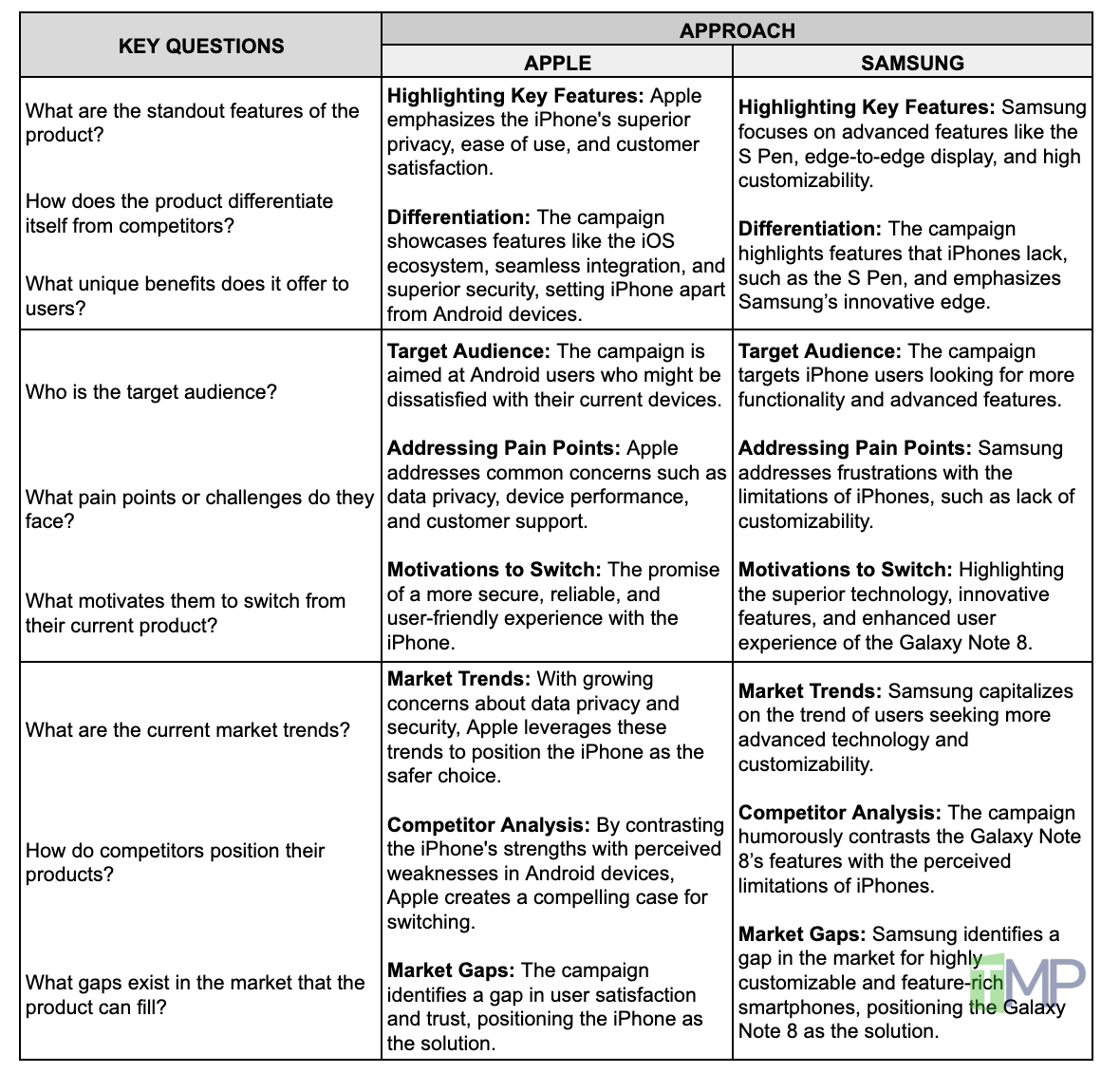Creating an exceptional Digital Marketing Campaign: Lessons from Apple and Samsung
By conducting thorough internal and external analysis and defining a strong USP, brands can effectively capture market share and convert users from competing products.
Creating a successful digital marketing campaign requires a blend of creative storytelling, strategic thinking, and data-driven insights. In this blog post, I’m analyzing the 2017´s Apple’s "Switch to iPhone" and Samsung’s "Upgrade to Galaxy Note 8" campaigns to provide a comprehensive guideline on how to develop an impactful marketing campaign. We'll discuss the internal and external analyses needed and how they translate into a compelling creative execution.
Overview of the Campaigns
Apple’s "Switch to iPhone" Campaign
Apple’s "Switch to iPhone" campaign targeted Android users, emphasizing the ease of transition, superior user experience, and robust security features. The campaign utilized user testimonials, clear messaging, and comparative advertising to highlight the benefits of switching to an iPhone.
Results:
Revenue Growth: In Q4 2017, Apple reported $52.6 billion in revenue, with 46.7 million iPhones sold.
Market Share: Increased iPhone sales, especially among former Android users, boosted Apple’s market share.
User Base Growth: The campaign effectively attracted a significant number of Android users to the iPhone ecosystem.
Samsung’s "Upgrade to Galaxy Note 8" Campaign
Samsung’s "Growing Up" ad humorously highlighted the limitations of iPhones compared to the Galaxy Note 8, showcasing advanced features like the S Pen and edge-to-edge display. The ad followed a character’s journey of frustration with his iPhone, culminating in his decision to switch to a Galaxy Note 8.
Results:
Market Penetration: Successfully highlighted the Note 8’s features, attracting users seeking more functionality.
Brand Perception: Positioned Samsung as an innovative leader in smartphone technology, appealing to frustrated iPhone users.
Internal and External Analysis: Building the Foundation
Before crafting a campaign, conducting thorough internal and external analyses is crucial. This helps identify the strengths, weaknesses, opportunities, and threats (SWOT) associated with the product and the market.
Breakdown of the Thought Process
Internal Analysis
Apple:
Product Strengths:
Seamless integration within the Apple ecosystem.
Superior security features and regular updates.
User-friendly interface and high customer satisfaction.
Customer Insights:
Android users often face fragmentation and inconsistent updates.
Security concerns with some Android devices.
Desire for a smoother and more reliable user experience.
Brand Positioning:
Apple positioned itself as a premium, secure, and user-friendly option.
Emphasized the seamless transition and superior performance of iPhones.
Previous Campaigns:
Analyzed past campaigns to identify successful strategies, such as user testimonials and highlighting product strengths.
Samsung:
Product Strengths:
Innovative features like the S Pen and edge-to-edge display.
High performance and advanced technology.
Customizability and flexibility of Android.
Customer Insights:
Frustration with the perceived limitations of iPhones.
Desire for more advanced features and customizability.
Preference for larger screens and stylus functionality.
Brand Positioning:
Samsung positioned itself as an innovator and leader in advanced technology.
Highlighted the superior features of the Galaxy Note 8 compared to iPhones.
Previous Campaigns:
Evaluated successful humorous and comparative ads to engage viewers and highlight product strengths.
External Analysis
Market Trends:
Increasing demand for high-security features and seamless user experiences.
Growing interest in advanced technology and innovative features.
Competitive Analysis:
Apple focused on Android’s fragmentation and security issues.
Samsung targeted iPhone’s perceived lack of innovation and flexibility.
Target Audience:
Apple aimed at Android users seeking a more secure and reliable experience.
Samsung targeted iPhone users frustrated with limitations and seeking advanced features.
Economic Factors:
Considered economic conditions impacting consumer spending and preferences.
Both companies aimed to attract users looking for better value and superior features.
Crafting the Campaign: From Analysis to Execution
Once all insights are on the table is time to put everything on a blender to get the precise Unique Selling proposition of the campaigns, next a table of how i would have done the analysis ifI were part of those marketing teams:
The Unique Selling Proposition and campaign details
1. Define the Unique Selling Proposition (USP):
Apple: Focused on ease of transition, security, and superior user experience.
Samsung: Highlighted advanced features, innovation, and the frustrations with iPhones.
2. Develop Creative Concepts:
Apple: Used user testimonials and clear visual comparisons to make a compelling case for switching.
Samsung: Leveraged humor and visual storytelling to engage viewers and highlight the Galaxy Note 8’s superior features.
3. Execute Across Multiple Channels:
Apple: Precision-targeted ads on digital platforms frequented by Android users.
Samsung: Engaging and shareable content on social media and online platforms.
4. Measure and Optimize:
Use data and analytics to track campaign performance.
Adjust strategies based on real-time feedback to maximize conversions and engagement.
Conclusion
Both Apple’s "Switch to iPhone" and Samsung’s "Upgrade to Galaxy Note 8" campaigns provide valuable lessons in crafting effective marketing strategies.
For marketers, these campaigns underscore the importance of understanding the target audience, leveraging data-driven insights, and creating compelling narratives that resonate with consumers.
By following these guidelines and learning from successful campaigns like those of Apple and Samsung, marketers can develop impactful strategies that drive conversions and enhance brand perception.




